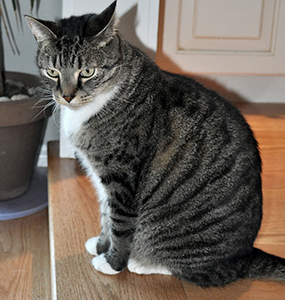
For more from Dr. Justine Lee, find her at www.drjustinelee.com or on Facebook!
Last week, we talked about causes of “acute strokes” – or things that look similar – in dogs. In dogs, some causes of “acute stroke” are actually benign causes like old dog vestibular disease. In severe cases, it may be due to malignant causes like a brain tumor.
This week, we’ll cover cats and what causes their “acute strokes.” Unfortunately, the causes of “acute stroke” in cats are not often benign as compared to dogs, and are often due to underlying disease.
 It’s scary to see your cat suddenly not be able to walk, look drunk, fall over to his or her side, have a head tilt, or act neurologically inappropriate (e.g., seizure). Other signs that look like “acute strokes” in cats include:
It’s scary to see your cat suddenly not be able to walk, look drunk, fall over to his or her side, have a head tilt, or act neurologically inappropriate (e.g., seizure). Other signs that look like “acute strokes” in cats include:
- sudden imbalance
- falling over to the side
- not being able to walk
- vomiting
- nausea
- inappetance (who wants to eat when they are nauseated?)
- rolling or circling to one side
- nystagmus (abnormal eye movement)
When this happens, there are four primary causes:
- an ischemic event secondary to hypertension
- a life-threatening blood clot called a "saddle thrombus"
- vestibular disease
- a brain tumor
In older cats, secondary hypertension (high blood pressure) may be a result of chronic kidney disease, hyperthyroidism (an overactive thyroid gland), or even cardiac disease. With uncontrolled hypertension (in other words, if it wasn’t previously diagnosed or isn’t responding to blood pressure medication called “Norvasc,” or amlodipine), an acute ischemic event can occur. This means that lack of blood flow occurs in a region (typically in the brain or spinal cord), and results in neurologic abnormalities. Thankfully, ischemic events often respond well to symptomatic supportive care and anti-hypertensive blood pressure medications. However, these ischemic events can leave permanent neurologic defects in your cat like wobbliness, a head tilt, etc.
The second cause may be due to a blood clot (commonly called a “saddle thrombus”). This is typically due to severe heart disease, and may result in severe pain. Due to the complexity of this disease, which typically has a poor prognosis, I’ll cover it in a separate blog.
The third cause is similar to old dog vestibular disease in dogs. While cats rarely get acute vestibular disease (like a tinnitus in humans), it can occur acutely for several reasons: from ear infections; from a tumor in the ear; from sticking a Q-tip too far down in your cat’s ear; cleaning your cat’s ear with liquid ear medications; from old trauma or underlying metabolic problems; or just simply for no reason at all (we call this reason idiopathic vestibular disease in cats, which is a fancy way of saying that we have no idea what caused it!).
Lastly, underlying cancer or infections in the brain or spinal cord can cause these signs. When in doubt, a CT or MRI may be necessary to diagnose what’s going on. But before potentially euthanizing for an “acute stroke,” make sure to check with a veterinarian. Simple tests like a blood pressure, thyroid level, kidney test, and chest x-rays are a great place to start to help rule out some of the more benign versus malignant causes.
If you have any questions or concerns, you should always visit or call your veterinarian -- they are your best resource to ensure the health and well-being of your pets.
